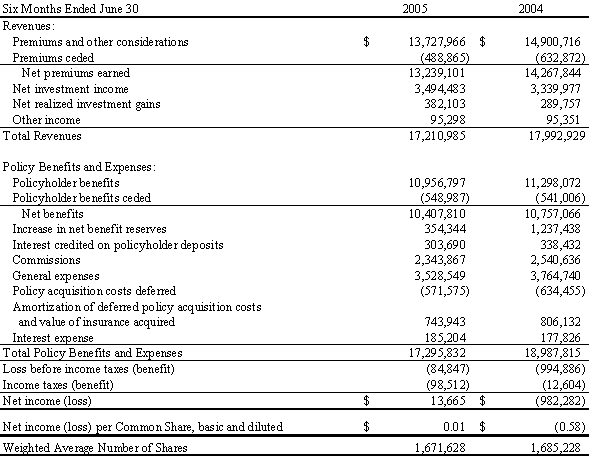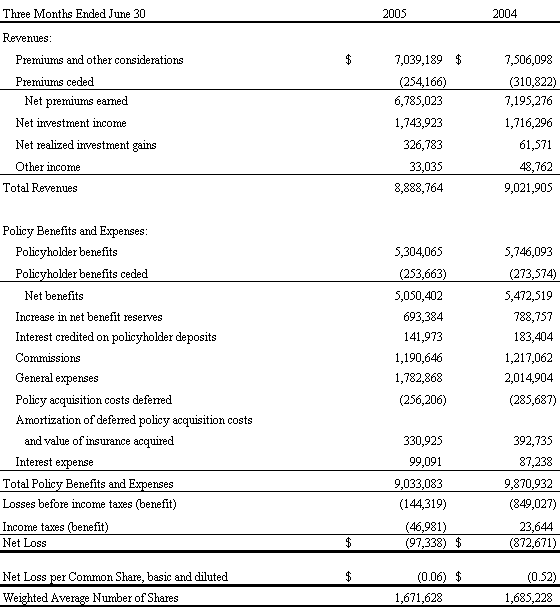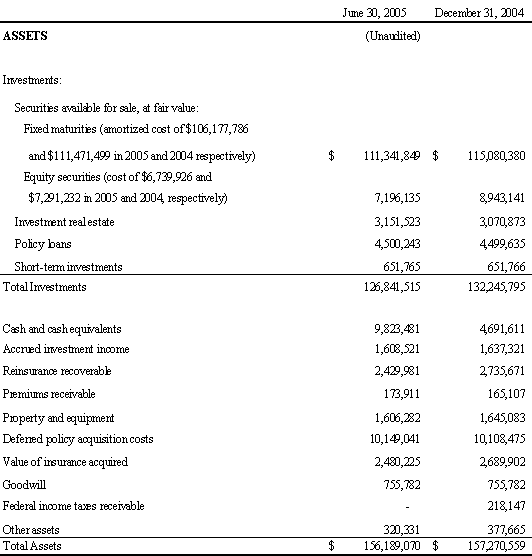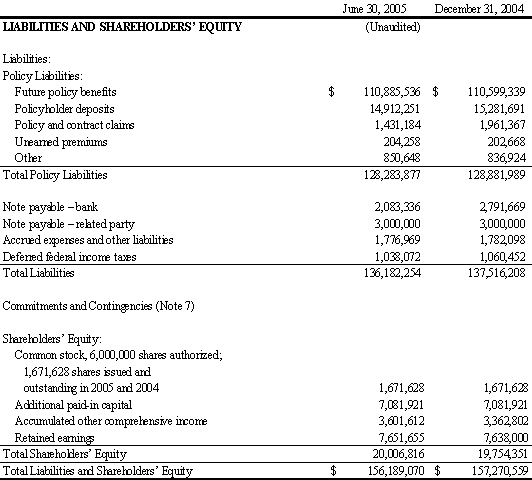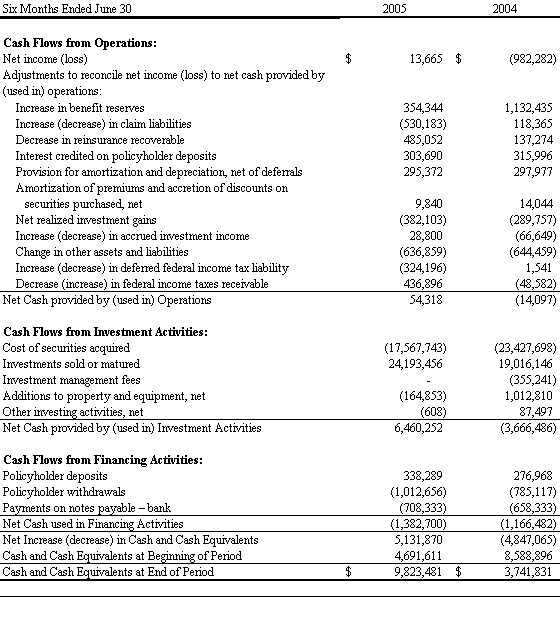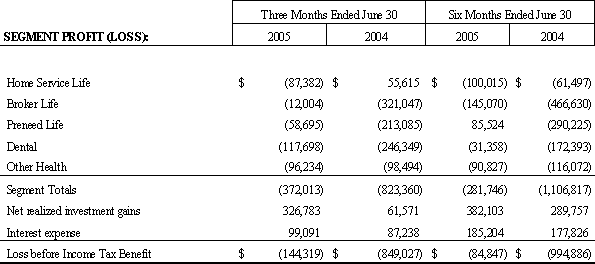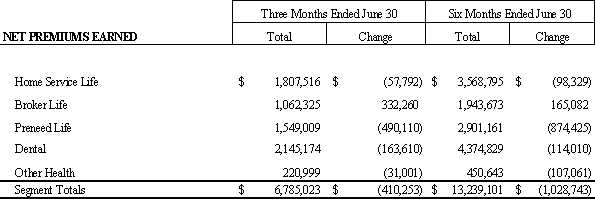Home Service Life premiums decreased approximately 2.7% during the first six months of 2005 compared to the same period in 2004 due to higher lapse rates. Broker Life premiums increased in the first six months of 2005 compared to the same period of 2004 because the Company has been aggressively developing relationships with new Managing General Agents to market the new final expense product introduced this year. Net premiums earned for the new final expense product was $215,000 during the first half of 2005 while premiums on old Broker Life products declined $50,000 because the Company is no longer writing first year business on those products. Preneed Life premiums continued to decreased during the first six months of 2005 compared to the same period in 2004 as the result of the Company further lowering crediting rates related to face amount growth in late 2004, and changing the focus of our marketing efforts. Dental premiums decreased during the first six months of 2005 compared to the first six months of 2004 because the Company has not renewed a large group with an unacceptable loss ratio and has strengthened renewal underwriting standards in an effort to improve the loss ratio for this product. The Dental loss ratio for the first six months of 2005 was 71.2% compared to 72.8% for the same period in 2004. Other Health premiums declined because in October 2004 the Company discontinued writing a disability plan which had been experiencing an unacceptable loss ratio. The Other Health segment products are not being actively marketed as the Company continues to redirect the focus of its marketing efforts to the Home Service, Broker and Dental segments in an effort to improve profitability in those segments.
Net benefits decreased $349,000, or 3.2% during the first six months of 2005 compared to the first six months of 2004 due primarily to a slightly improved mortality rate in the Broker Life segment. The increase in net benefit reserves decreased $883,000 during the first six months of 2005 compared to the same period in 2004 primarily due to the decrease in Preneed policies issued and in force during the period. Commissions decreased $197,000 or 7.7% for the first half of 2005 compared to the same period of 2004 due to the decreased premiums collected for the period. As discussed above, General expenses decreased $236,000, or 6.3% during the first half of 2005 compared to the same period of 2004. The net deferral/amortization of policy acquisition costs increased $1,000 for the six months ended June 30, 2005 compared to the same period in 2004 principally due to the decline in first year Preneed premiums during the same period.
Pretax loss decreased approximately $910,000 to $(85,000)for the six months ended June 30, 2005 compared to ($995,000) for the same period in 2004. Net investment income increased $155,000, or 4.6% for the first half of 2005 compared to the same period of 2004, in spite of a modest decline in invested assets and cash and cash equivalents due to an increased yield on the Company’s fixed maturities portfolio resulting from investing in longer term fixed maturity securities. Net realized investment gains increased to $382,000 for the first six months of 2005 from net investment gains of $290,000 for the same period in 2004.
Pretax Segment loss (excluding realized investment gains and interest expense) for the first six months of 2005 was approximately ($282,000) compared to ($1,107,000) for the first six months of 2004. This is attributable to the factors described above. Following are the approximate, annualized pretax investment income and “total return” yields (defined as yields including net investment income, net realized investment gains or losses and net change in the excess or deficit of market values over book values of the investment portfolios or unrealized gains (losses)) for the six months ended June 30, 2005 and 2004. Net realized gains totaled $327,000 and $382,000 for
the three and six months ended June 30, 2005, respectively and $62,000 and $290,000 for the three and six months ended June 30, 2004, respectively, while unrealized gains (losses), net of deferred taxes totaled $1,955,000 and $239,000 for the three and six month periods ended June 30, 2005, respectively and $(4,191,000) and $(2,820,000) for the three and six month periods ended 2004, respectively.

The Company has recorded no current income tax recoverable due to management’s judgment that it is not likely the full tax benefit will be realized in the foreseeable future.
FINANCIAL POSITION. Shareholders’ equity totaled approximately $20,007,000 and $19,754,000 at June 30, 2005 and December 31, 2004, respectively. These balances reflect an approximate 1.28% increase for the six months ended June 30, 2005. Comprehensive income (loss) totaled approximately $252,000 and $(3,802,000)for the six months ended June 30, 2005 and 2004, respectively. A significant portion of the comprehensive income (loss) is attributable to changes in the value of the Company’s fixed maturity and equity portfolios. Equity securities comprised approximately 4.6% and 5.7% of the Company’s total assets as of June 30, 2005 and December 31, 2004, respectively. Accordingly, movements in the equities markets can significantly affect the Company’s financial position. Equity portfolio positions decreased $551,000 on a cost basis and $1,747,000 on a market value basis, during the first six months of 2005. Fixed maturity portfolio positions decreased $5,294,000 on an amortized cost basis and $3,739,000 on a market value basis during the same period. These decreases result from the disposal of many equity securities and below investment grade fixed maturity securities in an effort to increase the risk adjusted capital levels of the Company’s insurance subsidiaries. Cash and cash equivalent positions increased, pending investment, approximately $5,132,000 during the six months ended June 30, 2005.
The equity and fixed maturities markets continue to be highly volatile and were favorable in the second quarter and first half of 2005. Interest yields on fixed maturity investments held in our portfolio are continuing to slowly increase. Low short-term rates continue to adversely impact the Company’s investment portfolio yield and operating earnings. The 2005 environment continues to generate a relatively high level of qualitative investment risk. However, measures of quantitative risk per unit of investment are not believed to have changed significantly from those previously disclosed in the Company’s 2004 Form 10-K.
OFF-BALANCE SHEET ARRANGEMENTS
The Company does not participate in any off-balance sheet arrangements.
CASH FLOWS AND LIQUIDITY. Cash provided by (used in) operations totaled $54,000 for the six months ended June 30, 2005 compared to $(14,000) for the same period in the prior year. The increase in the positive cash flow is primarily attributable to the decrease in the pretax segment loss. The $6,460,000 of cash provided by investing activities for the six months ended June 30, 2005 resulted from the net decrease in the investment portfolio on a cost basis, offset by increased investment in equipment. The $1,383,000 of cash used in financing activities during the first six months of 2005 is attributable to bank loan principal repayments along with net annuity and Universal Life account withdrawals. Due to continued earnings pressure from low yields on investments and cash equivalents and the declining Preneed premiums, the Company completed a strategic review of its products and operations in 2004. A key element of this initiative is improving profitability of the Preneed, Home Service, and Broker Life segments by increasing premiums in the Home Service and Broker segments, strengthening underwriting practices, modifying commissions, and where possible, lowering interest crediting or
16
policy growth rates. Regarding the currently scheduled bank debt repayments, the Company believes its available assets will be adequate to service 2005 debt obligations. The Company’s Chairman has expressed potential willingness to loan the Company an additional $2,000,000 if necessary, which could service bank debt obligations through 2007. For the quarter ended June 30, 2005, the Company did not meet one of its bank debt covenants (debt to earnings ratio); however, the lender has waived this violation for the quarter and for several previous quarters. In return for the waivers the Company’s Chairman has personally guaranteed the outstanding bank debt.
FORWARD-LOOKING INFORMATION.
All statements, trend analyses and other information contained in this report relative to markets for the Company’s products and trends in the Company’s operations or financial results, as well as other statements including words such as “anticipate”, “believe”, “plan”, “estimate”, “expect”, “intend”, and other similar expressions, constitute forward-looking statements under the Private Securities Litigation Reform Act of 1995. These forward-looking statements are subject to known and unknown risks, uncertainties and other factors which may cause actual results to be materially different from those contemplated by the forward-looking statements. Such factors include, among other things:
• | the market value of the Company’s investments, including stock market performance and prevailing interest rate levels; |
• | customer and agent response to new products, distribution channels and marketing initiatives, including exposure to unrecoverable advanced commissions; |
• | mortality, morbidity, lapse rates, and other factors which may affect the profitability of the Company’s insurance products; |
• | regulatory changes or actions, including those relating to regulation of insurance products and insurance companies; |
• | ratings assigned to the Company’s insurance subsidiaries by independent rating organizations which the Company believes are important to the sale of its products; |
• | general economic conditions and increasing competition which may affect the Company’s ability to sell its products; |
• | the Company’s ability to achieve anticipated levels of operating efficiencies and meet cash requirements based upon projected liquidity sources; |
| • | unanticipated adverse litigation outcomes; and | |
• | changes in the Federal income tax laws and regulations that may affect the relative tax advantages of some of the Company’s products. |
| | | | |
There can be no assurance that other factors not currently anticipated by management will not also materially and adversely affect the Company’s results of operations.
Part I; Item 3 - Quantitative and Qualitative Disclosures about Market Risk
Quantitative and Qualitative Risk. The primary changes in quantitative market risks during the six months ended June 30, 2005 are discussed in Part I, Item 2 above.
Part I; Item 4 – Controls and Procedures
EVALUATION OF DISCLOSURE CONTROLS AND PROCEDURES. Within the past 90 days, the Company conducted an evaluation of its disclosure controls and procedures, with the supervision and participation of its Chief Executive Officer and Principal Financial Officer. The Company does not expect that its disclosure controls and procedures will prevent all errors and fraud. Such a control system, no matter how well conceived and operated, can provide only reasonable, not absolute, assurance that the objectives of the control system are met. Further, the design of a control system must balance the constraint of prudent resource expenditure with a judgmental evaluation of risks and benefits. Based on this evaluation of disclosure controls and procedures, the Company’s Chief Executive Officer and Principal Financial Officer have concluded that such controls and
17
procedures provide reasonable assurance that material information required to be included in the Company’s periodic SEC reports is made known on a timely basis to the Company’s principal executive and financial officers.
CHANGES IN INTERNAL CONTROLS. There have been no significant changes in the Company’s internal controls or changes in other factors that could significantly affect these controls subsequent to their evaluation, nor has the Company implemented any corrective actions regarding significant deficiencies or material weaknesses in internal controls.
18
Part II – Other Information
a). | Exhibit 11 | Statement re: computation of per share earnings. | |
| Exhibit 31.1 | Rule 13a-14(a)/15d-14(a) Certification --Principal Executive Officer |
| Exhibit 31.2 | Rule 13a-14(a)/15d-14(a) Certification --Principal Financial Officer | |
| Exhibit 32.1 | Section 1350 Certification --Principal Executive Officer | |
| Exhibit 32.2 | Section 1350 Certification --Principal Financial Officer | |
| | | | | | | | |
SIGNATURES
In accordance with the requirements of the Securities and Exchange Act of 1934, the registrant caused this report to be signed on its behalf by the undersigned, thereunto duly authorized.
CITIZENS FINANCIAL CORPORATION |
| /s/ Darrell R. Wells |
BY: |
| Darrell R. Wells |
| President and Chief Executive Officer |
| /s/ Len E. Schweitzer |
BY: |
| Len E. Schweitzer |
| Treasurer and Principal Financial Officer |
Date: August 12, 2005
19
